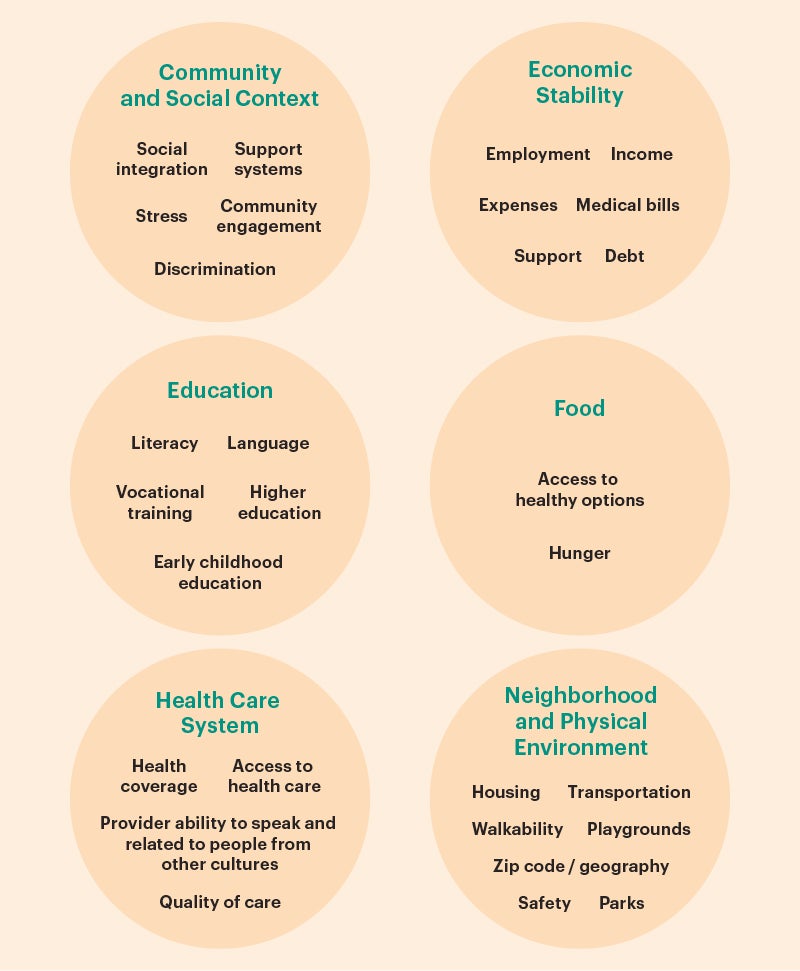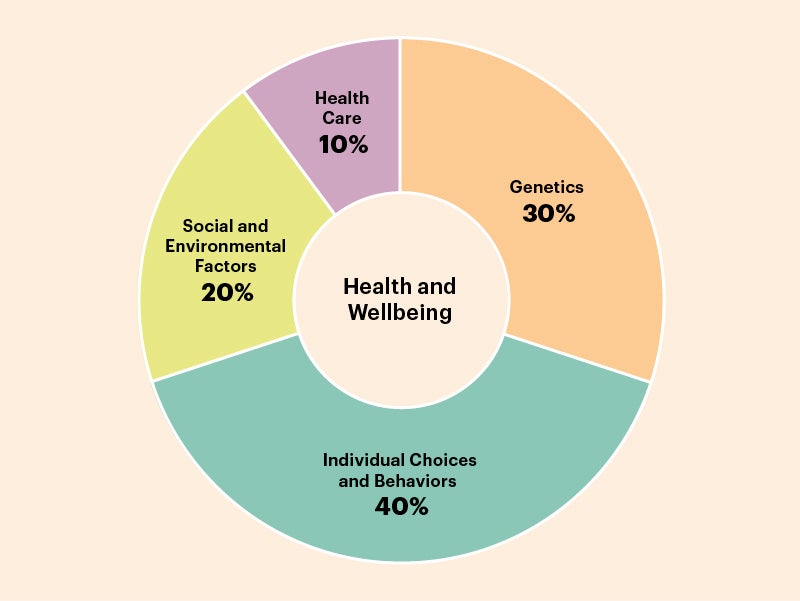What Is the Procedure They Put a Tube in Your Back to Your Kidney
Social Determinants of Kidney Disease
There are many environmental, medical, and social factors that contribute to an increased risk of developing kidney disease, also known as chronic kidney disease or CKD. These factors include: having more than one disease (for example, high blood pressure or diabetes), your family's medical history, where you live, where you work, where you play, how you are perceived by others, and how you have personally experienced discrimination.
Environmental and social factors or social determinants of health (SDoH) make it more difficult for people to enjoy healthy lifestyles and get the medical attention, access to care, and support they need. SDoH also include physical and emotional factors, which lead to added stresses and can negatively affect your health. These are some of the SDoH that have been found to contribute to people developing kidney disease.
Key social determinants linked to poor health:
Food insecurity
A household-level experiencing an emotional or financial crisis, in which family members have uncertain or inadequate access to food.
A recently unemployed single mom who does not have enough money to buy food for her children.
Housing instability
Due to either emotional or financial problems, family members face uncertainty, such as having trouble paying rent, overcrowding, moving frequently, staying with relatives, or spending the bulk of household income on housing.
A victim of domestic abuse who courageously left their abuser but now does not have a safe place to stay — all too often they may return to the abuser — and end up in an even worse position — all because there is nowhere else to go.
Unreliable transportation
Unable to access affordable, convenient, reliable transportation, which leads to difficulties getting places, including, school, daycare, grocery stores, medical appointments, and more.
A patient with kidney failure who needs dialysis to survive — but there is no public transportation to get to the closest dialysis center or hospital, which is 20 miles away.
Safety fears
Concerns about domestic or neighborhood violence, which includes victimization, witnessing violence, and crime.
An elderly grandmother who watches her 4 grandchildren every day while her daughter and son-in-law are at work — but she can't take the kids to the playground or to the grocery store, and sometimes even to school, because armed robberies and violent assaults are common in her neighborhood.
Inadequate access to utilities
Limited or unreliable access to water, electricity, phone, internet, WIFI, and gas for the household, including lack of refrigeration or plumbing.
A family renting an apartment is still reliant on a landlord to maintain the building and pay utilities — when the landlord does not take care of their responsibilities — the tenants are the ones who pay the price.
More social determinants linked to poor health:
Few educational opportunities
Poor access to effective educational and community-based programs.
Poor income and employment opportunities
A direct outcome of limited educational opportunities, resulting in further upstream economic inequities including job security, work environment, financial compensation, and job demands — all of which affect health.
Environment exposures
Physical, chemical, environmental, and biological factors that affect health, which include:
- Outdoor air quality
- Surface and ground water quality
- Toxic substances and hazardous wastes
- Homes and communities (for example, indoor air pollution, also known as sick building syndrome, foundational, structural and ventilation problems within the home, lead-based paint)
Social determinants of health

Understanding how SDoH can affect kidney health is important. Many people only learn that they have kidney disease when the disease is already advanced. SDoH, like not having access to preventive care in their neighborhoods or lacking transportation to get to their doctor, can contribute to late diagnoses of kidney disease. People who are at risk should be regularly tested to see how well their kidneys are working.
Kidney disease risk factors
There are a number of environmental and social factors that can increase your risk of developing kidney disease. These SDoH contribute to developing serious chronic conditions such as high blood pressure, diabetes (also called sugar diabetes or sugar disease), lupus, or being overweight, which can lead to kidney disease. In addition, your genetics or having family members with kidney disease may also play a role.
It's not always easy to be healthy or have a healthy lifestyle. And why is that? Well—the short answer is that many people, especially people living, working, and learning in under-resourced communities, simply do not have access to the very basics that are needed, such as open and green spaces like parks, reliable public transportation, healthy foods to eat, and appropriate medical care.1
People with kidney disease may have difficulty getting needed medical care due to several factors, all of which can contribute to life-threatening complications. Often, people may have limited access to needed medical options and care due to where they live.
Other reasons include not having health insurance, not having a regular doctor who knows you and your medical history, and local healthcare and policy issues, which do not provide a clear path for patients to follow. For example, if you are pregnant and unable to get good prenatal care, you can end up developing eclampsia (a type of high blood pressure that can occur during pregnancy and can cause seizures – which can be life-threatening to both baby and mom), as well as other conditions, and can possibly lead to long-term kidney damage.
Factors related to health and wellbeing

Is race a risk factor for chronic kidney disease?
Over 37 million adults in the United States have kidney disease. A disproportionate number self-identify as Black/African American, Hispanic/Latino, American Indian/Alaska Native, Asian American, Native Hawaiian or Other Pacific Islander, or multiracial, and face unacceptable health disparities and inequities in medical care access.
For many people, the factors that contribute to increased risk for developing kidney disease include lower socioeconomic status, fewer than 12 years of education, and food insecurity. These factors disproportionately affect communities of color.
Race-based social, financial, and political decisions made decades ago continue to place barriers around communities of color, which led to fewer investments in their neighborhoods. Limited financial, political, and environmental resources contributed to the inequalities that exist in these communities, and include not having access to quality schools, high-paying jobs, open green spaces, healthy food options, and necessary medical care.
While it is true — people who self-identify as Black/African American, Hispanic/Latino, and American Indian/Alaska Native are at high risk for developing kidney failure, this is due to environmental and social factors in under-resourced urban and rural communities of color, which also is a contributing factor to the high rates of diabetes and high blood pressure in these communities.
Eliminating health inequities requires a long-term commitment and the use of several approaches. Through community collaboration and sharing information that is thoughtful, relevant, and culturally sensitive, we can keep enthusiasm high and empower community members to help them take control of their health and lead them on the road the greater well-being.
Reference:
- Tucker JK. What's behind racial disparities in kidney disease? Harvard Health Blog. 2021 February 03. Available at: https://www.health.harvard.edu/blog/whats-behind-racial-disparities-in-kidney-disease-2021020321842 Accessed: June 29, 2021.
Date Reviewed: 11-04-2021
What Is the Procedure They Put a Tube in Your Back to Your Kidney
Source: https://www.kidney.org/atoz/content/kidneydiscauses
0 Response to "What Is the Procedure They Put a Tube in Your Back to Your Kidney"
Post a Comment